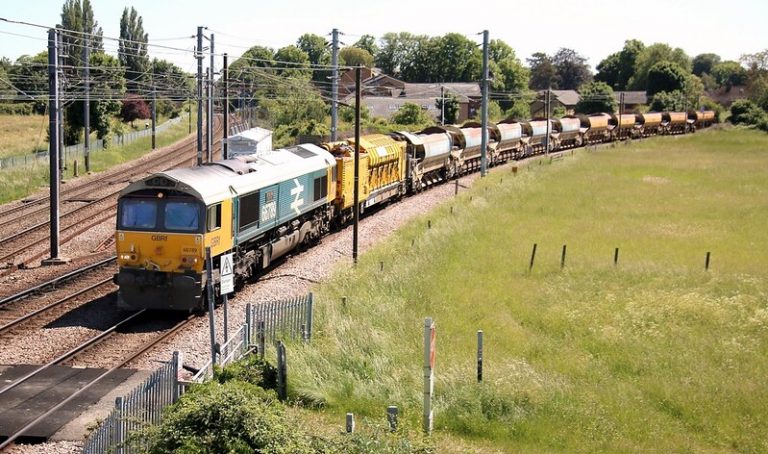The #TfNTalks webinar highlighted concerns surrounding the new Transport for the North’s Freight and Logistics Strategy. Quadrant Transport examines key points from the webinar for the rail freight industry.
Transport for the North held a webinar yesterday to enable the public to voice their interests surrounding the upcoming TfN Freight and Logics Strategy.
Industry experts came together to talk about the importance of the efficient movement of goods, and the urgent need for decarbonisation for the North’s economy.
Chaired by Nancy Fielder, Editor of The Star, the event saw discussions from Sir Peter Hendy CBE, Chair of Network Rail, Peter Kennan, TfN Board Member for South Yorkshire Local Enterprise Partnership and Maggie Simpson OBE, Director General of the Rail Freight Group, followed by a public Q&A.
Starting the event’s discussions, Sir Peter Hendy CBE highlighted how now is an optimal time for a review due to the Covid-19 recovery with passenger rail, and the current environmental, decarbonisation and sustainability agendas.
He said: “It’s the first time for a very long time that rail freight might have an advantage over road freight simply because decarbonisation of heavy lorries seems to be further away (in terms of technology) than the decarbonisation of the railways.
“That’s a great opportunity for the railways to get more involved in freight transport and it’s one that we ought to take. But of course, it’s all dependent on investment.”
In 2021, the total rail freight lifted was 19.8 million tonnes in the UK
Talking about investment opportunities in the UK, Sir Peter Hendy CBE continued: “There may well be places outside the North of England where investment needs to be made in order to facilitate freight and logistics to and from the North of England.
That’s one of the principals of the Union Connectivity Review, which is that investment in one part of the country can facilitate economic development in another, and we have to be mindful of that when we look at where the government is putting and spending its money.”
Moving on, Peter Kennan began his analysis by stating how transport is a “key mechanism to drive growth” within the economy.
That’s why he believed the Integrated Rail Plan was “so disappointing”, as “there was no integrated joined-up thinking of the network.”
He continued: “There was no real focus on freight and decarbonisation, or on capacity generation which is the very thing that HS2 and NRP are there to deal with.
The Freight and Logistics Strategy gives us an opportunity to get engagement and free thinking on this key area. It will then help TfN develop its updated Strategic Transport Plan and to inform conversations within government on developments within the North.”
Maggie Simpson OBE also mentioned how improving the planning of freight and logistics across the North will also benefit all sectors across the UK.
She said: “We won’t get the rebalancing of the economy or the levelling up that the region needs unless we have effective freight distribution that is cost-effective and affordable for businesses.
“We won’t decarbonise the economy in the North of England unless we make more use of the low carbon rail and water, and decarbonise freight transport across the region. This strategy gives a framework in which we can help rail freight grow.”
Electrification and connectivity were key concerns within the webinar
The Q&A enabled the public to put forward suggestions and concerns towards the upcoming strategy. Throughout many questions, rolling programmes of electrification proved to be the top question of the event.
Rail electrification is essential for freight as well as passenger trains. Economies will be achieved through a rolling programme putting back in the long term through costs and carbon reduction.
With that, Quadrant Transport asked: How do we persuade the government to back this?
Sir Peter Hendy CBE told Quadrant Transport: “The rate and cost would be better if there was a continuous programme of electrification, but it does have to be a progressive programme and have regard for passenger movements as well as freight movements.”
This was backed by Peter Kennan as he said: “I fully support rolling programmes because we have to keep skilled people occupied, and we’ve got to get more skilled people.”
The final question concerning rail freight saw an interesting perspective on the priority of the railway: Does the tradition of giving passenger trains preference over freight trains need revision?
Peter Kennan started the discussion by stating that both should be given priority: “I would hope we get to a point where we don’t have to make those choices because we’ll have the capacity that’s needed to accommodate all users of the network.”
However, this was contradicted by Sir Peter Hendy CBE as he said: “It would be nice to think that it would never be needed to make a choice between capacity for passenger trains and capacity for freight.
“However, I think we’re never likely to get to that point in my lifetime because the railway has been relentlessly filling up with trains over the last 25 years. I think over the next few years there will be increasing pressure from both passengers and freight.”
TfN’s Freight & Logistics Strategy is now out to public consultation, giving everyone the chance to find out more about the opportunities and challenges facing the North of England when it comes to moving goods.
There is a virtual consultation room where anyone can provide their feedback, with the consultation open until 31 January 2022. Click the link to find out more: www.transportforthenorth.com/freight-logistics/

